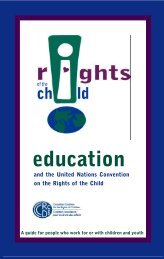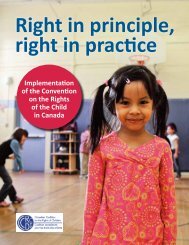Poste - Canadian Coalition for the Rights of Children
Poste - Canadian Coalition for the Rights of Children
Poste - Canadian Coalition for the Rights of Children
You also want an ePaper? Increase the reach of your titles
YUMPU automatically turns print PDFs into web optimized ePapers that Google loves.
C A N A D I A N C O A L I T I O N F O R T H E R I G H T S O F C H I L D R E N<br />
<strong>Children</strong>’s Participation at Jamieson<br />
School, Sydney, NS<br />
Youth Speaks Up involves young people in<br />
decision-making on social issues at <strong>the</strong> Jamieson<br />
elementary school in Sydney, Nova Scotia.<br />
<strong>Children</strong> <strong>for</strong>m <strong>the</strong>ir own committee and get<br />
toge<strong>the</strong>r with students from o<strong>the</strong>r schools to share<br />
<strong>the</strong>ir views on various current issues. <strong>Children</strong> are<br />
trained to make positive and socially aware<br />
decisions and to become involved in <strong>the</strong><br />
community. 21<br />
living in poverty. However, many observers have<br />
expressed concern that school expenses and field trip<br />
costs are <strong>of</strong>ten left to parents or <strong>the</strong> community to raise,<br />
leading to unequal access and stigmatization <strong>of</strong> <strong>the</strong><br />
underprivileged.<br />
Data from <strong>the</strong> National Longitudinal Study <strong>of</strong> <strong>Children</strong><br />
and Youth found that <strong>the</strong> late elementary school years are<br />
a positive experience <strong>for</strong> most young people in Canada.<br />
“They are achieving in school, feel good about<br />
<strong>the</strong>mselves, have positive attitudes toward school and<br />
believe that <strong>the</strong>ir parents and teachers support <strong>the</strong>ir<br />
academic ef<strong>for</strong>ts.” 22<br />
Physical Health<br />
The <strong>Canadian</strong> Paediatric Society and <strong>the</strong> <strong>Canadian</strong><br />
Teachers’ Federation have urged parents, politicians and<br />
policy makers to take steps to increase <strong>the</strong> physical<br />
activity levels <strong>of</strong> children. Two national studies by <strong>the</strong><br />
Heart and Stroke Foundation and <strong>Canadian</strong> Fitness and<br />
Lifestyle Research Institute found that <strong>the</strong> health <strong>of</strong> 63<br />
percent <strong>of</strong> <strong>Canadian</strong> children is at risk due to high levels<br />
<strong>of</strong> physical inactivity. There is an increasing reliance on<br />
television, video games and computer technology during<br />
leisure time, in addition to an overall decline in physical<br />
education in schools. The <strong>Canadian</strong> Teachers’ Federation<br />
notes, however, that <strong>the</strong>re is little consensus on how to<br />
achieve <strong>the</strong> appropriate balance between academic and<br />
physical education within <strong>the</strong> core curriculum. 23<br />
In November 1998, a round-table meeting <strong>of</strong><br />
representatives <strong>of</strong> federal, provincial and municipal<br />
80<br />
governments and non-governmental organizations<br />
(NGOs) developed a variety <strong>of</strong> strategies to ensure<br />
physical activity and recreation opportunities <strong>for</strong><br />
children living in poverty. 24<br />
National and International Assessments<br />
In <strong>the</strong> Third International Ma<strong>the</strong>matics and Science<br />
Survey <strong>of</strong> Grade 8 students in over 50 countries,<br />
<strong>Canadian</strong> students did as well as or better in<br />
ma<strong>the</strong>matics than students in 30 o<strong>the</strong>r countries and<br />
not as well as those from 10 countries. In science,<br />
<strong>Canadian</strong> students did as well as or better than<br />
students in 31 countries and not as well as those from<br />
9 countries. 25<br />
The trend towards more testing is related to issues <strong>of</strong><br />
standards and expectations. However, <strong>the</strong> <strong>Canadian</strong><br />
Teachers’ Federation criticizes national and<br />
international testing, questioning <strong>the</strong> validity <strong>of</strong> results<br />
and arguing that <strong>the</strong> tests do not assess <strong>the</strong> broader<br />
aims <strong>of</strong> education, such as promoting citizenship,<br />
ethics, character and respect <strong>for</strong> o<strong>the</strong>rs. Fur<strong>the</strong>rmore,<br />
<strong>the</strong> distinct nature <strong>of</strong> <strong>the</strong> various education systems in<br />
Canada means that aggregated national testing results<br />
“are an inadequate measure <strong>of</strong> <strong>the</strong> efficiency <strong>of</strong> <strong>the</strong>se<br />
systems,” according to education commentator David<br />
Ireland. 26 Yet in 1995, <strong>the</strong> Council <strong>of</strong> Ministers <strong>of</strong><br />
Education, Canada, supported testing <strong>of</strong> students’<br />
achievement in <strong>the</strong> arts, social sciences and civics and<br />
recommended that testing <strong>for</strong> <strong>the</strong>se areas be developed<br />
to assess a wider range <strong>of</strong> subjects and skills <strong>of</strong><br />
<strong>Canadian</strong> students. 27<br />
Aboriginal Students<br />
In addition to facing <strong>the</strong> challenges <strong>of</strong> non-Aboriginal<br />
students, Aboriginal children have to cope with <strong>the</strong><br />
legacy <strong>of</strong> social disintegration resulting from<br />
colonialism and <strong>the</strong> <strong>for</strong>ced removal <strong>of</strong> children to<br />
attend residential schools. Consequently, Aboriginal<br />
children attain lower overall levels <strong>of</strong> educational<br />
achievement compared with o<strong>the</strong>r <strong>Canadian</strong> children. 28<br />
The table below compares <strong>the</strong> highest level <strong>of</strong><br />
education attained in 1991 by all adult <strong>Canadian</strong>s with<br />
<strong>the</strong> highest level attained by adults who identified<br />
<strong>the</strong>mselves as Aboriginal. More than half <strong>of</strong> <strong>the</strong><br />
Aboriginal adult population did not complete high<br />
school.




